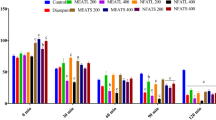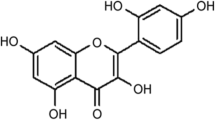Abstract
Background
Abuse of more than one psychoactive drug is becoming a global problem. Our experiments were designed to examine the effects of a concomitant administration of 3,4-methylenedioxy-methamphetamine (MDMA) and mephedrone on depression- and anxiety-like behaviors and cognitive processes in Swiss mice.
Methods
In order to investigate the drug interactions the forced swimming test (FST) — an animal model of depression, the passive avoidance (PA) test — a memory and learning paradigm, as well as the elevated plus maze (EPM) test — test for anxiety level were used.
Results
The results revealed that a concomitant administration of non-effective doses of mephedrone (1 mg/kg) and MDMA (1 mg/kg) exerted marked antidepressive effects in the FST. Also a co-administration of mephedrone (2.5 mg/kg) and MDMA (1 mg/kg) displayed a pro-cognitive action in the PA paradigm. Furthermore, even though mephedrone and MDMA can, in general, exert some anxiogenic effects in mice, the concomitant administration of nonactive doses of both drugs (0.05 and 0.1 mg/kg, respectively) in the EPM test, did not show any synergistic effect in our study.
Conclusions
The effects of mephedrone and MDMA combination on mammalian organisms were attempted to be evaluated in our study and the results are described in the present report. These results may help explain the reasons for and consequences of a concomitant administration of psychoactive substances with regards to the central nervous system, while being possibly useful in the treatment of polydrug intoxication.
Similar content being viewed by others
References
Andersson B, Hibell B, Beck F, Choquet M, Kokkevi A, Fotiou A, et al. Alcohol and Drug Use Among European. 17–18 year old students. ESPAD; 2007.
Maurer HH. Chemistry, pharmacology, and metabolism of emerging drugs of abuse. Ther Drug Monit 2010;32:544–9.
Hadlock GC, Webb KM, McFadden LM, Chu PW, Ellis JD, Allen SC, et al. 4-Methylmethcathinone (mephedrone), neuropharmacological effects of a designer stimulant of abuse. J Pharmacol Exp Ther 2011;339(2):530–6.
Kehr J, Ichinose F, Yoshitake S, Goiny M, Sievertsson T, Nyberg F, et al. Mephedrone, compared with MDMA (ecstasy) and amphetamine, rapidly increases both dopamine and 5-HT levels in nucleus accumbens of awake rats. Br J Pharmacol 2011;164(8):1949–58.
Martínez-Clemente J, Escubedo E, Pubill D, Camarasa J. Interaction of mephedrone with dopamineand serotonin targets in rats. Eur Neuropsychopharmacol 2012;22(3):231–6.
Motbey CP, Hunt GE, Bowen MT, Artiss S, McGregor IS. Mephedrone (4-methylmethcathinone, ‘meow’): acute behavioural effects and distribution of Fos expression in adolescent rats. Addict Biol 2012;17(2):409–22.
Baumann MH, Ayestas Jr. MA, Partilla JS, Sink JR, Shulgin AT, Daley PF, et al. The designer methcathinone analogs, mephedrone and methylone, aresubstrates for monoamine transporters in brain tissue. Neuropsychopharmacology 2012;37(5):1192–203.
Capela JP, Carmo H, Remiao F, Bastos ML, Meisel A, Carvalho F. Molecular and cellular mechanisms of ecstasy-induced neurotoxicity: an overview. Mol Neurobiol 2009;39:210–71.
Leonardi ET, Azmitia EC. MDMA (ecstasy) inhibition of MAO type A and type B: comparisons with fenfluramine and fluoxetine (Prozac). Neuropsychopharmacology 1994;10(4):231–8.
White SR, Obradovic T, Imel KM, Wheaton MJ. The effects of methylenedioxymethamphetamine (MDMA, ecstasy) on monoaminergic neurotransmission in the central nervous system. Prog Neurobiol 1996;49:455–79.
Europol — EMCDDA Joint report on a new psychoactive substance: 4-methylmethcathinone (mephedrone) European Monitoring Centre for Drugs and Drug Addiction (EMCDDA) Lisbon, Portugal (2010).
Angoa-Pérez M, Kane MJ, Briggs DI, Francescutti DM, Sykes CE, Shah MM, et al. Mephedrone does not damage dopamine nerve endings of the striatum, but enhances the neurotoxicity of methamphetamine, amphetamine, and MDMA. J Neurochem 2013;125(1):102–10.
Angoa-Pérez M, Kane MJ, Francescutti DM, Sykes KE, Shah MM, Mohammed AM, et al. Mephedrone, an abused psychoactive component of ‘bath salts’ and methamphetamine congener, does not cause neurotoxicity to dopamine nerve endings of the striatum. J Neurochem 2012;120(6):1097–107.
Angoa-Perez M, Kane MJ, Herrera-Mundo N, Francescutti DM, Kuhn DM. Effects of combined treatment with mephedrone and methamphetamine or 3,4-methylenedioxymethamphetamine on serotonin nerve endings of the hippocampus. Life Sci 2014;97(1):31–6.
Martínez-Clemente J, López-Arnau R, Abad S, Pubill D, Escubedo E, Camarasa J. Dose and time-dependent selective neurotoxicity induced by mephedrone in mice. PLoS One 2014;9(6):e99002.
Budzynska B, Boguszewska-Czubara A, Kruk-Slomka M, Kurzepa J, Biala G. Mephedrone and nicotine: oxidative stress and behavioral interactions in animal models. Neurochem Res 2015;40(5):1083–93.
Ciudad-Roberts A, Camarasa J, Pubill D, Escubedo E. Heteromeric nicotinic receptors are involved in the sensitization and addictive properties of MDMA in mice. Prog Neuropsychopharmacol Biol Psychiatry 2013;44:201–9.
Daza-Losada M, Rodríguez-Arias M, Maldonado C, Aguilar MA, Guerri C, Miñarro J. Acute behavioural and neurotoxic effects of MDMA plus cocaine in adolescent mice. Neurotoxicol Teratol 2009;31(1):49–59.
López-Arnau R, Martínez-Clemente J, Pubill D, Escubedo E, Camarasa J. Comparative neuropharmacology of three psychostimulant cathinone derivatives: butylone mephedrone and methylone. Br J Pharmacol 2012;167(2):407–20.
Porsolt RD, Bertin A, Jalfre M. Behavioral despair in mice: a primary screening test for antidepressants. Arch Int Pharmacodyn Ther 1997;229:327–36.
Budzynska B, Boguszewska-Czubara A, Kruk-Slomka M, Skalicka-Wozniak K, Michalak A, Musik I, et al. Effects of imperatorin on nicotine-induced anxiety- and memory-related responses and oxidative stress in mice. Physiol Behav 2013;122:46–55.
Allami N, Javadi-Paydar M, Rayatnia F, Sehhat K, Rahimian R, Norouzi A, et al. Suppression of nitric oxide synthesis by L-NAME reverses the beneficial effects of pioglitazone on scopolamine-induced memory impairment in mice. Eur J Pharmacol 2011;650:240–8.
Javadi-Paydar M, Zakeri M, Norouzi A, Rastegar H, Mirazi N, Dehpour A. Involvement of nitric oxide in granisetron improving effect on scopolamine-induced memory impairment in mice. Brain Res Rev 2012;1429:61–71.
Biala G, Budzynska B. Effects of acute and chronic nicotine on elevated plus maze in mice: involvement of calcium channels. Life Sci 2006;79(1):81–8.
Lister RG. The use of a plus-maze to measure anxiety in the mouse. Psychopharmacology 1987;92(2):180–5.
Chimakurthy J, Talasila M. Effects of curcumin on pentylenetetrazole-induced anxiety-like behaviors and associated changes in cognition and monoamine levels. Psychol Neurosci 2010;3:239–44.
Majumder I, White JM, Irvine RJ. Antidepressant-like effects of 3,4-methylenedioxymethamphetamine in an animal model of depression. Behav Pharmacol 2011;22(8):758–65.
Hirschfeld RM. History and evolution of the monoamine hypothesis of depression. J Clin Psychiatry 2000;61:4–6.
Green AR, Mechan AO, Elliott JM, O’Shea E, Colado MI. The pharmacology and clinical pharmacology of 3,4-methylenedioxymethamphetamine (MDMA, ecstasy). Pharmacol Rev 2003;55(3):463–508.
Tsuji M, Takeda H, Matsumiya T. Modulation of passive avoidance in mice by the 5-HT1A receptor agonist flesinoxan: comparison with the benzodiazepine receptor agonist diazepam. Neuropsychopharmacology 2003;28(4):664–74.
Zeeuws I, Deroost N, Soetens E. Effect of an acute d-amphetamine administration on context information memory in healthy volunteers: evidence from a source memory task. Hum Psychopharmacol 2010;25(4):326–34.
Meneses A, Ponce-Lopez T, Tellez R, Gonzalez R, Castillo C, Gasbarri A. Effects of d-amphetamine on short-and long-term memory in spontaneously hypertensive, Wistar-Kyoto and Sprague-Dawley rats. Behav Brain Res 2011;216:472–6.
Wiig KA, Whitlock JR, Epstein MH, Carpenter RL, Bear MF. The levo enantiomer of amphetamine increases memory consolidation and gene expression in the hippocampus without producing locomotor stimulation. Neurobiol Learn Mem 2009;92:106–13.
Ciccarone D. Stimulant abuse: pharmacology cocaine methamphetamine treatment attempts at pharmacotherapy. Prim Care 2011;38:41–58.
McKetin R, Mattick RP. Attention and memory in illicit amphetamine users. Drug Alcohol Depend 1997;48(3):235–42.
Strupp BJ, Bunsey M, Levitsky D, Kesler M. Time-dependent effects of post? trial amphetamine treatment in rats:evidence for enhanced storage of representational memory. Behav Neural Biol 1991;56(1):62–76.
Bernabeu R, Bevilaqua L, Ardenghi P, Bromberg E, Schmitz P, Bianchin M, et al. Involvement of hippocampal cAMP/cAMP-dependent protein kinase signaling pathways in a late memory consolidation phase of aversively motivated learning in rats. Proc Natl Acad Sci U S A 1997;94(13):7041–6.
Bethus I, Tse D, Morris RGM. Dopamine and memory: modulation of the persistence of memory for novel hippocampal NMDA receptor dependent paired associates. J Neurosci 2010;30:1610–8.
Imperato A, Obinu MC, Gessa GL. Effects of cocaine and amphetamine on acetylcholine-release in the hippocampus and caudate nucleus. Eur J Pharmacol 1993;238:377–81.
Day JC, Fibiger HC. Dopaminergic regulation of septohippocampal cholinergic neurons. J Neurochem 1994;63:2086–92.
Hoge EA, Ivkovic A, Fricchione GL. Generalized anxiety disorder: diagnosis and treatment. BMJ 2012;345:e7500.
Bergink V, van Megen HJ, Westenberg HG. Glutamate and anxiety. Eur Neuropsychopharmacology 2004;14(3):175–83.
Lenz J, Brown J, Flagg S, Oh R, Batts K, Ditzler T, et al. Cristalius: a case in designer drugs. Mil Med 2013;178(7):e893–5.
McCardle K, Luebbers S, Carter JD, Croft RJ, Stough C. Chronic MDMA (ecstasy) use cognition and mood. Psychopharmacology 2004;173:434–9.
Moon M, Do KS, Park J, Kim D. Memory impairment in methamphetamine dependent patients. Int J Neurosci 2007;117:1–9.
Wood DM, Dargan PI. Novel psychoactive substances: how to understand the acute toxicity associated with the use of these substances. Ther Drug Monit 2012;34(4):363–7.
den Hollander B, Rozov S, Linden AM, Uusi-Oukari M, Ojanperä I, Korpi ER. Long-term cognitive and neurochemical effects of bath salt designer drugs methylone and mephedrone. Pharmacol Biochem Behav 2013;103:501–9.
Lin HQ, Burden PM, Christie MJ, Johnston GA. The anxiogenic-like and anxiolytic-like effects of MDMA on mice in the elevated plus-maze: a comparison with amphetamine. Pharmacol Biochem Behav 1999;62(3):403–8.
Morley KC, McGregor IS. (±)-3,4-Methylenedioxymethamphetamine (MDMA, ecstasy) increases social interaction in rats. Eur J Pharmacol 2000;408: 41–9.
Author information
Authors and Affiliations
Corresponding author
Rights and permissions
About this article
Cite this article
Budzynska, B., Michalak, A., Frankowska, M. et al. Acute behavioral effects of co-administration of mephedrone and MDMA in mice. Pharmacol. Rep 69, 199–205 (2017). https://doi.org/10.1016/j.pharep.2016.10.006
Received:
Revised:
Accepted:
Published:
Issue Date:
DOI: https://doi.org/10.1016/j.pharep.2016.10.006




